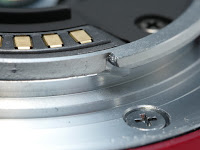Below, we see basic kit zoom lenses for Nikon DX DSLR cameras (left), and for Nikon 1 (right):
Beyond the size and mount difference between them, there is one difference that many notice: The DSLR lens (left) has a plastic (nylon) bayonet mount, while the newer Nikon 1 CX lens has a metal bayonet. And this fact is often noticed by online reviewers, stating that all Nikon 1 lenses have metal mounts.
So, Nikon have taken the feedback from the users and put more metal on the lenses? Everybody should be happy! Except that this is wrong: The bayonet mount is not metal, it is chromed plastic.
If you feel the bayonet with your fingers, you will easily feel that it is not a metal material. However, you don't need to trust my feeling. To prove this to you, I am presenting some photographic evidence, as you should expect.
Here are two pancake Nikon 1 lenses: The red one is the Nikon 1 10mm f/2.8, one of the few CX lenses which does have a metal bayonet. On the right is the same Nikon PD 10-30mm f/3.5-5.6 as above.
You can notice that the metal has a different shimmer in this image: The right hand bayonet has a more matte, dull toned look. Closeup images reveal further differences:
| Nikon 1 10mm f/2.8 | Nikon PD 10-30mm f/3.5-5.6 |
Even closer images to help you see the difference:
To the left, you can see the tooling marks from the genuine metal bayonet of the red 10mm lens. This further illustrates why a metal mount is so much more expensive: It needs to go through a number of finishing processes to get the right shape.
On the right, you see the chromed plastic mount of the kit zoom lens. There are no tooling marks at all, but the bayonet has marks from the plastic molding process. Also, there are some parts of the chrome finish which have chipped off.
Conclusion
Most Nikon 1 lenses have a chromed plastic bayonet mount. There is nothing wrong about this, in my opinion, plastic is a completely adequate material for a small lens mount.
It is a bit sad that Nikon feel they need to hide the fact that the bayonets are plastic. But this is probably a very rational decision:
If it had been uncovered plastic, they would have gotten many poor online reviews, saying that the lenses have a poor build quality. Which would have been an unfair comment. Also, the chroming may decrease the friction when mounting the lens, and, hence, improve the life span of the bayonet.
There are some Nikon 1 lenses still which do have metal bayonets: The Nikon 1 10mm f/2.8 (seen here in red), the Nikon PD 10-100mm f/4.5-5.6, the Nikon 10-100mm f/4.0-5.6, the Nikon 32mm f/1.2 portrait lens, and finally, the Nikon 70-300mm f/4.5-5.6 long tele lens.
The Nikon FT-1 mount adapter also has a metal bayonet.
Also, the waterproof Nikon 1 AW 11-27.5mm f/3.5-5.6 lens does have a metal bayonet. I haven't seen the Nikon 1 AW 10mm f/2.8 lens, but given that it's non-waterproof sibling has a metal bayonet, I would guess that this one also does.
Beyond these exceptions, the rest of the Nikon 1 lenses have plastic bayonet mounts.





No comments:
Post a Comment